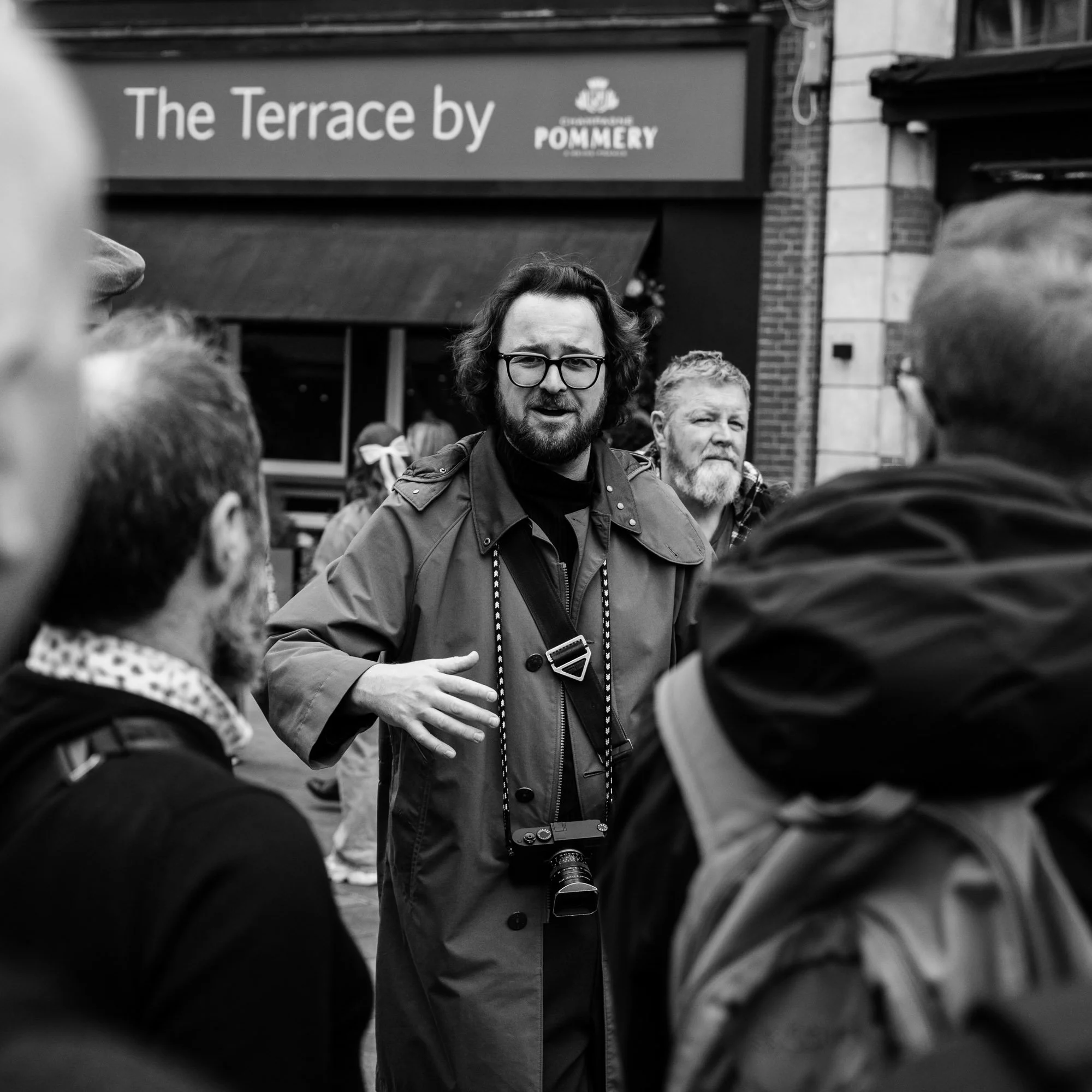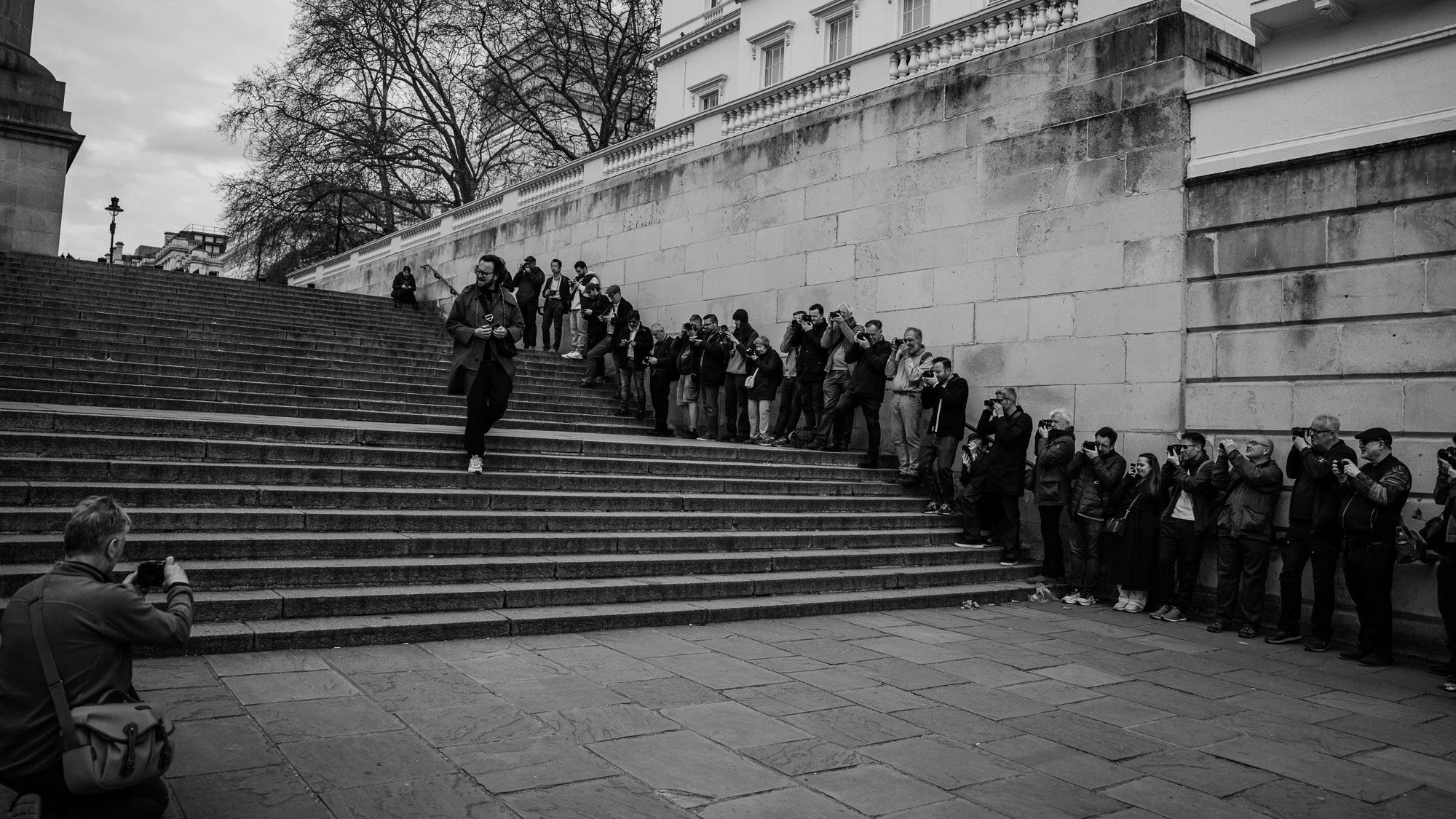A Photo Walk with Alan Schaller
On Saturday 22nd of March 2025, I attended a 3 hour photo walk through parts of London with Alan Schaller and some of his other Patreon supporters.
We met outside St James’ Park tube station at 11am and I’m not sure what I was expecting but I was greeted by a group of roughly forty, mainly middle aged men yielding Leica’s with a few Fujifilm, Sony and Olympus cameras mixed in. By my best guess, I reckon there was at least around £200k of Leicas there - a thieves dream.
I had taken my Sony A7 iV teamed with my Sigma 24-70mm 2.8 DG DN II Art Lens, in anticipation of the day being a more interactive session with a smaller group but due to the number of people that turned up it ended up being a bit more one sided in terms of Alan talking, taking a few photos, moving location and talking some more. Luckily, Alan was very engaging, full of interesting ideas and anecdotes and generally just entertaining to be around.
Overall it was a really interesting experience and something I would definitely do again given the opportunity. The photographic career Alan has established for himself in such a relatively short period of time is incredible so getting to spend time with him and hear his advice first hand was invaluable.
My main take aways from the day were the importance of;
setting yourself projects
giving yourself limitations
looking at your work as a collective
shooting consistently with a purpose
being idea obsessed instead of gear obsessed
Setting Projects
Setting yourself projects was one of the first things Alan spoke about and really resonated with me. Without a project it’s too east to go out shooting and end up frustrated and jumping from one observation to another without any kind of coherence or theme.
He summed it up really nicely at one point by saying without a project in mind, you’re essentially walking around looking for everything and nothing at the same time, which by it’s nature is a sure fire way to become exhausted, uninspired and disappointed at the end of the day.
If you go out with projects in mind, you start looking for things related to that project, you get in the zone quicker and even if the images you capture on that particular day aren’t amazing, they are at least part of something bigger and so have purpose.
Projects could be something quite broad - Light and Shadow, or they could be something much more specific - The Colour Red on Brompton Road. Alan highlighted that the more specific a project is the more likely it is to tell a story and, if being published is an aim, then you’re more likely to create a unique body of work that tells a new story and so is more likely to attract attention from photography bloggers and magazines etc.
Projects should also be achievable, there’s no point doing a project on Skyscrapers of the World if you don’t have the time, budget or access to actually fly around the world and execute the project, instead you should focus on projects that resonate with you and that are within your reach, Pigeons of Hyde Park, Pavements of Sheffield or The Night Bus in Glasgow is something much more accessible to shoot if you live in any of those locations.
Whilst these projects might seem mundane on the face of it, that’s almost exactly the point, a seemingly mundane subject forces you to think more creatively about how you might capture that in an interesting and visually striking way.
As you shoot your projects and get in the ‘zone’, you’ll start to see relevant images everywhere and go from struggling for inspiration to needing bigger memory cards.
Limitations
If all options are open to you then you’ll spend more time figuring what camera or focal length to use instead of documenting the subject you’ve identified and the moment might pass you by.
By setting limitations it’s also much easier to fully master the operational aspects of the gear you’ve chosen so you can focus on bringing your vision to life rather than be sat figuring out controls you rarely use.
Limitations we can implement on ourselves might be things like what camera and focal length we use, whether we shoot in black and white, what time of day we shoot, the perspective we adopt, the style of shooting (hip shooting, long exposure, etc…)
Alan stated that the majority of his work is done with one camera, two fixed focal length lenses and in black and white.
These kind of limitations also allow us to develop a more consistent style of our own, which in turn helps type our overall body of work together.
On this, I think there is no right or wrong however I worry that if everyone picks up a Fujifilm X100 series camera, sets it to a film replica preset and heads out to shoot from the hip then there’s a big danger that we all just blend in to one style thats particularly popular right now but that will just fade in to a sea of same images.
The limitations you set yourself should compliment your project, shooting close-ups of dried flower heads is probably going to be easier with a macro lens compared to a super wide distorting fish eye lens. Or maybe it would be interesting to use the opposite to what you should use and thats how you tell the story of your project through a different perspective compared to other photographers.
Once you set you'r limitations you’ll also start see the world through the lens of these limitations, you’ll develop a sixth sense of finding images that lend themselves to shooting with those limitations in mind.
Looking at the Collective
Aspiring photographers are always trying to find their style - myself included.
Alan shared how his style has evolved over the years and said all too often people assume he’s shot his trademark high contrast black and white style from day one but this is not the case. He encouraged us to take a look at his Flickr account to see some of his early images, I did this and, with all due respect, it brought me some comfort that even someone as skilled, talented and artistically gifted as Alan started somewhere more akin to the majority of photographers.
An exercise he suggests to help identify trends in your work is something he did when compiling images for his book Metropolis, he suggests printing as many of your images out as you can as small prints, just a few images on their longest side, lay them all out and start to group them by whatever you notice ties different images together.
By doing this you should start to identify trends across your images, things you do without noticing it and when you look at your photos in isolation you won’t see it, but when you view them as a collective it will become clear.
Alan says once you identify these trends in your work, you’ll find you start to shoot with them in mind and before long you’ll have developed a refined style of your own and you’ll start to see the world in that way.
Shoot Consistently
Ok, so we’ve got our projects, limitations and we’re developing a style of our own, now it’s time to put the miles in and practice.
Alan advises that there’s nothing better you can do to improve your photography than getting out and practicing. He even suggests you don’t necessarily need a camera to do this, if you find yourself with some spare time but no camera to hand, you can still practice finding images in a scene, you do everything apart from actually press the button.
Find the subject, explore options, think about the technical settings you’d use and then take the image mentally.
Of course it is best to practice photography with a camera and actually go through the full process from idea to finished image.
Set time aside to get out and practice, even if it’s just 10 minutes a day, get your camera in your hand, get used to shooting with it until you get to the point where you can use the controls without thinking about it so you are free to focus on everything apart from the operation of your camera when the next potential images presents itself to you.
10 minutes a day is better than 1 hour per week but 1 hour a week is better than nothing, so just do as much as you can.
Ideas Over Gear
This is something that I see so often and Alan summed it up so well.
How many times have you seen a technically brilliant image that evokes no emotion or story, it’s great in one sense but completely pointless in another. This is what Alan described as someone having all the gear and no idea, whereas he sees photography as 90% ideas and 10% gear.
He said the mark of a good photographer isn’t what camera and lens they use but the ideas they have and their ability to bring that vision to life.
Give a bad photographer the best camera in the world and they’ll still produce boring pointless images, give a good photographer the most basic equipment and they’ll still create engaging images that tell a story.
I recently traded in my Canon 6D DSLR and a couple of lenses against the purchase of my Sony A7 iV and a Sigma 24 - 70mm 2.8 DG DN II Art Lens, that initial new gear buzz lasted a little while but soon passed and what I’m actually finding is it’s too big to carry around all the time and so I’ve started putting my Olympus Trip 35 film camera in my pocket instead.
Alan says that unless you’re finding purpose and fulfilment out of the process of creating the images you create, then it really doesn’t matter what you’re shooting them on on or how often you update your equipment, the best thing is to find what works for you, learn how to use it and stick with it.
The first question a lot of aspiring photographers often ask when they see an image they like “is what settings and camera did you use?” and Alan says this is equivalent to being served a beautiful meal in a restaurant and asking what brand of oven and gas mark the chef used when the really important question is more around what inspired the dish and how did you create that flavour profile?
Alan being a model whilst the group practice the panning technique he uses in some of his images

